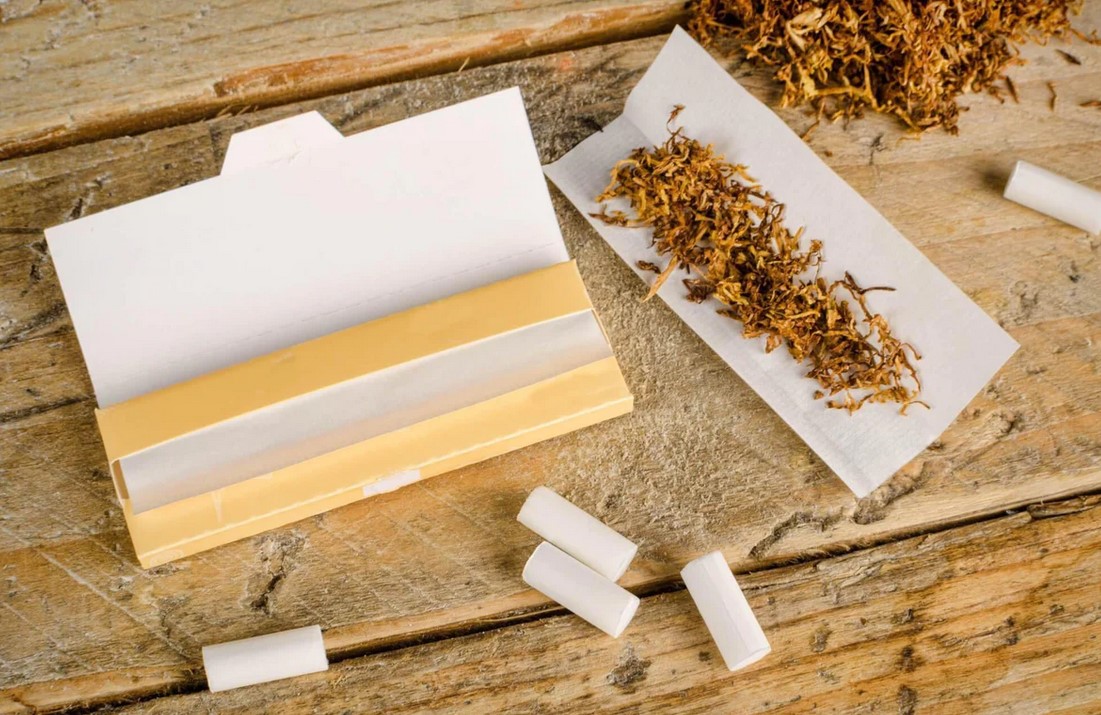Uncategorized
Rolling Papers Guide
Trying to decide which type of rolling paper is best for you, but don’t know where to start? Check out this article, which will go over the different types of papers available and how they can change your smoking experience. With this knowledge in hand, you’ll be able to make a more informed decision when buying your next pack!
Although a good quality rolling paper can improve the taste and smell of your joint, as well as your smoking experience, nothing beats the skill required for a perfect roll-up. And learning how to craft these joints takes years. Despite recent popularity in vaporizers, smoking cannabis joints is still the most common way to enjoy all the benefits this plant has to offer.
Traditional rolling papers are often made of wood pulp, which has some advantages and disadvantages when smoking. In recent years, as more people have become focused on health conscience choices, an increased number of cannabis-related options have entered the market. These include rice paper, hemp paper, and even transparent cellulose rolling papers that better satisfy the needs of the public.
When it comes to rolling papers, there are tons of different options out there. It can be tough to know which kind is right for you. But don’t worry – we’re here to help. Here’s a breakdown of the most common materials used in rolling papers and their respective characteristics:C
Common Characteristics of Rolling Papers
Stepping into a smoke shop, you might feel overwhelmed by the vast amount of rolling papers available–and they all claim to be special in some way. Although they may look similar on the surface, these papers can differ quite significantly. A few factors that could affect your decision when choosing a paper are size, flavour, style/form, and colour/design.
Size
Rolling papers typically come in the following pre-cut sizes:
- Standard size rolling papers (also known as single wide)
- 1¼” rolling papers
- 1½” rolling papers
- Double wide rolling papers
- King size rolling paper
- King slim rolling papers
Flavour
As anyone who’s smoked knows, rolling papers come in all sorts of flavours, from fresh menthol to dark chocolate.
- Mint or menthol
- Green apple
- Watermelon
- Banana
- Cherry
- Berry (strawberry, raspberry, or blueberry)
Many rolling papers do not come with any added flavor, except for the taste of the paper.
Style
Rolling a cigarette can be challenging for some, but it’s something that takes time and patience to learn. If you haven’t perfected your rolling technique yet or would rather let the experts handle it, try pre-rolled cones or wraps! Simply fill them with your desired herb, twist the top shut, and enjoy an amazing smoke in mere minutes. For those of you who like to roll from a flat sheet of paper instead, don’t worry – there are plenty of booklets out there that will make your life much easier while traveling.
Colour and Design
Rolling papers come in a variety of colours and materials, from unbleached brown or white to more decorative stamped designs. You can also find pre-rolled cones that are 24″ long ~ perfect for sharing during parties! Or if you’re feeling extra fancy, try gold leaf rolling paper to get a taste of the high life.
White vs Brown Rolling Papers: What’s the Difference?
Rolling papers have different levels of porosity to ensure an even burn. The paper may also contain other materials that help stabilize the smoke and slow down the burning process. White rolling papers usually contain some form of chemical, such as chlorine or calcium carbonate, which helps to control the rate of combustion. Rolling papers that are flavoured or coloured often contain chemicals, or even natural substances, which can be harmful when inhaled. Many brands now offer papers that are made without chemical treatments or materials that improve combustion, reducing the possible harm and aftertaste of your smoke.

Most Common Rolling Paper Materials
The table below displays the most prevailing materials used for rolling papers. Some are more widely used than others and some chemicals significantly change them while other leave them nearly unprocessed. Also, each type of paper has a dissimilar burn rate and porosity.
1. Classic Wood Pulp Paper
Wood pulp rolling papers were once the most popular and continue to be used today. They are often mixed with other fibers, giving them a texture that makes them easy to handle. On average, these papers are thicker than newer types of paper, even though they come in a few different thicknesses—bleached or unbleached. White wood pulp papers have been bleached while brown ones have not yet received this chemical treatment.
Wood pulp papers have a solid texture that is perfect for beginners because they hold their shape well, even in humid or sweaty conditions. Wood pulp papers have a medium–fast burn rate and are not as popular among smokers compared to other materials.
2. Barely There Rice Paper
The best rice papers are made from all-natural ingredients, which means they’re basically just processed and pressed rice. These rolling papers usually have a thinner construction than other brands, making them better for your lungs. However, this smooth paper might not grip well between your fingers and is pretty vulnerable to certain conditions – especially damp air. Don’t smoke your weed in traditional papers when it’s raining outside. Rice paper is thin yet burns slowly. The little material used for a single sheet makes it a potentially better choice for your health, and for enjoying your weed without almost any external aftertaste.
3. Silky Smooth Flax Paper
While flax is sometimes used in rolling paper blends to achieve a similar result, there are also 100% flax papers that make for a nice alternative to rice papers. The flax plant produces bothflax seeds—a highly nutritious food rich in potential benefits—andflax fibre. Made from the plant’s natural long stems, fl ax fibre can be processed into an ultrathin yet durable and lightweight paper. Flax papers are not mainstream, but they offer a unique texture that strokes the skin smoothly and enables easy rolling. Flax papers burn slowly, allowing more time to enjoy your smoke. In addition, flax papers don’t interfere with the natural flavors/aromas of your herb.
4. Hemp Is a Smoker’s Friend
In the last two decades, industrial hemp has experienced a resurgence in popularity, and hemp rolling papers have been greeted with enthusiasm by stoners everywhere. Why? For starters, they help save trees as they’re made from hemp fiber instead of wood pulp. Also, most people who smoke cannabis prefer light brown papers since bleaching is generally not appreciated by weed consumers. Hemp papers are thicker and rougher than rice ones, but they provide a good grip when rolling. They also have a similar tendency to absorb (and eventually release) humidity. Their burn rate is medium and they go out less often than rice papers. Joints made with hemp paper might take on a delicate aftertaste that won’t spoil the aroma of the burning herb.
5. Old-School Esparto Paper
Esparto, also known as halfah grass, is a tall perennial grass that is grown as a crop in North Africa, Spain, and Portugal. Esparto is usually used to make baskets, cardboard, and even clothing. However, it can also be processed into paper. To make paper from espa to grass , the plant material is typically mixed with 5–10% wood pulp for easier processing. Even though esparto paper production is an ancient art, esparto rolling papers are quite rare. And for good reason; when burned, esparto produces carcinogenic smoke. Therefore, we recommend against using esparto papers for smoking!
How Are Rolling Papers Produced?
You might not have known this, but there are many diverse materials that rolling papers can be made out of. In truth, a lot of times, companies who make rolling papers will use different fibers mixed together to create the perfect texture and burn for when it’s time to smoke. Some fibers (like wood pulp) tend to burn quickly while other fibers (hemp is a great example) take much longer to catch fire. When you’re smoking, you’ll want a paper that burns slowly and evenly so the flavors of what you’re smoking aren’t altered or lost completely.
Manufacturers create pulp from the selected fibres to make their papers. After drying and pressing the pulp into a fine paper, some manufacturers then treat the rolling paper with chemicals. This affects features like the burn rate, colour, and flavour of the final product.
What Toxic Ingredients Are in Rolling Papers That You Should Avoid?
Remember that smoking is never safe, regardless of what you’re smoking or what rolling material(s) you’re using. When you burn plant materials, the intense heat from your lighter or match changes the chemicals in whatever you’re smoking. The resulting smoke contains harmful toxins as well as terpenes, flavonoids and cannabinoids (in cannabis). Many of these toxins are linked to cancer.
Although smoking is harmful to your health, you can still make healthier choices about the materials you smoke. By avoiding papers with toxic chemicals, you can enjoy a tastier and host smell while also minimizing your exposure to dangerous substances. Some of the common chemicals found in rolling papers are:
- Heavy metals: Some rolling papers test positive for heavy metals like arsenic, mercury, lead and cadmium – all of which are poisonous to humans and other living things.
- GMO fibres: Though the jury is still out on whether consuming genetically modified products has negative health effects, we prefer to err on the side of caution here at RQS. Therefore, we recommend that all smokers try to find GMO-free options whenever possible.
- Artificial dyes: Some coloured papers are created with natural dyes that come from food colourings, while others use chemical dyes. If you want to be safe, look for products made with natural dyes.
- Bleach and calcium carbonate: Did you know that many commercial rolling papers go through a bleaching process? Chlorine is commonly used for this purpose, however it’s highly toxic and can produce dangerous fumes. If you’re looking to cut down on your exposure to chemicals, consider using unbleached papers instead. Calcium carbonate is also often used as an alternative to chlorine bleach, and has the added benefit of producing a slow, even burn. As paper treated with calcium carbonate burns, it becomes increasingly porous, which affects the exchange of gases. Unfortunately, when in direct contact, calcium carbonate irritates the skin and eyes, as well as the respiratory tract if inhaled. When combusted, it produces irritating smoke.
- Potassium nitrate: Flavoured papers (particularly blunt wraps) often contain potassium nitrate, which is highly toxic. In its natural form, potassium nitrate irritates the skin and eyes upon contact exactly like it does when inhaled – causing nose, throat, and lung discomfort . Furthermore , in high concentrations , potassium nitrate can reduce oxygen transportation throughout the body leading to anaemia and death.
That’s a Wrap!
With so many different types of rolling papers on the market, it can be tough to decide which one is right for you. It often comes down to personal preference in regards to size, flavor, or color. Burning properties and price are other factors that come into play when making a decision. If possible, we recommend avoiding bleached or heavily processed rolling papers because they can negatively affect the flavor of your smoke and may contain harmful chemicals.


